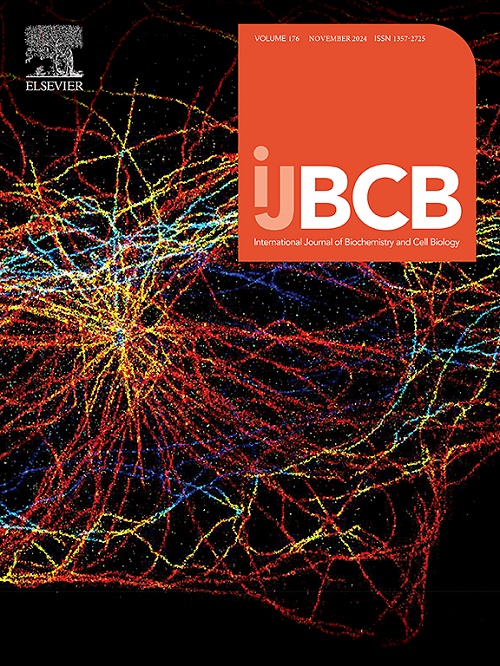Serine phosphorylation of protein arginine methyltransferase Hmt1 is critical for controlling its protein levels
IF 2.8
3区 生物学
Q2 BIOCHEMISTRY & MOLECULAR BIOLOGY
International Journal of Biochemistry & Cell Biology
Pub Date : 2025-05-19
DOI:10.1016/j.biocel.2025.106790
引用次数: 0
Abstract
In eukaryotes, protein arginine methylation is a prevalent post-translational modification found in a multitude of proteins responsible for key biological processes, ranging from transcription to signaling. One model suggests that phosphorylation of serine 9 (S9) in the Saccharomyces cerevisiae major protein arginine methyltransferase Hmt1 is critical for its oligomerization and activity. In this study, we used classic biochemical approaches to demonstrate that neither the S9 phosphomimetic nor the non-phosphorylatable substitution mutants of Hmt1 affect its oligomerization. These mutants remain active in vivo, retaining their ability to methylate the SR-/hnRNP-like protein Npl3 and displaying a monomethylarginine and asymmetric dimethylarginine banding profile similar to that of the wild-type. In cells lacking Dbf2, the proposed kinase responsible for phosphorylating Hmt1 at S9, Npl3 remains methylated. Additionally, monomethylarginine and asymmetric dimethylarginine banding profiles in cells lacking Dbf2 mostly resemble those observed in the wild-type rather than in hmt1Δ cells. Synchronized yeast cells expressing either S9 substitution exhibit entry into the M phase of the cell cycle at a rate similar to that of both wild-type and hmt1Δ cells. Our results suggest that the C-terminal epitope tagging of Hmt1 is responsible for the previously observed loss of enzymatic activities, rather than the S9 phosphorylation status of Hmt1. Finally, we demonstrate that S9 phosphorylation plays a role in maintaining Hmt1 protein levels in vivo. Overall, our finding demonstrates a novel role for Hmt1 S9 phosphorylation in tuning its in vivo protein levels.
蛋白精氨酸甲基转移酶Hmt1的丝氨酸磷酸化对控制其蛋白水平至关重要。
在真核生物中,蛋白质精氨酸甲基化是一种普遍的翻译后修饰,存在于许多负责从转录到信号传导等关键生物过程的蛋白质中。一种模型表明,酿酒酵母主要蛋白精氨酸甲基转移酶Hmt1中丝氨酸9 (S9)的磷酸化对其寡聚化和活性至关重要。在这项研究中,我们使用经典的生化方法来证明Hmt1的S9和非磷酸化取代突变体都不会影响其寡聚化。这些突变体在体内保持活性,保留了其甲基化SR-/ hnrnp样蛋白Npl3的能力,并显示出与野生型相似的单甲基精氨酸和不对称二甲基精氨酸带型。在缺乏Dbf2的细胞中,负责Hmt1在S9、Npl3位点磷酸化的激酶仍保持甲基化。此外,缺乏Dbf2的细胞中的单甲基精氨酸和不对称二甲基精氨酸带谱与野生型细胞中观察到的相似,而不是hmt1Δ细胞。表达S9替代的同步酵母细胞以与野生型和hmt1Δ细胞相似的速度进入细胞周期的M期。我们的研究结果表明,Hmt1的c端表位标记是导致先前观察到的酶活性丧失的原因,而不是Hmt1的S9磷酸化状态。最后,我们证明了S9磷酸化在维持体内Hmt1蛋白水平中发挥作用。总之,我们的发现证明了Hmt1 S9磷酸化在调节其体内蛋白水平中的新作用。
本文章由计算机程序翻译,如有差异,请以英文原文为准。
求助全文
约1分钟内获得全文
求助全文
来源期刊
CiteScore
8.10
自引率
0.00%
发文量
124
审稿时长
19 days
期刊介绍:
IJBCB publishes original research articles, invited reviews and in-focus articles in all areas of cell and molecular biology and biomedical research.
Topics of interest include, but are not limited to:
-Mechanistic studies of cells, cell organelles, sub-cellular molecular pathways and metabolism
-Novel insights into disease pathogenesis
-Nanotechnology with implication to biological and medical processes
-Genomics and bioinformatics

 求助内容:
求助内容: 应助结果提醒方式:
应助结果提醒方式:


